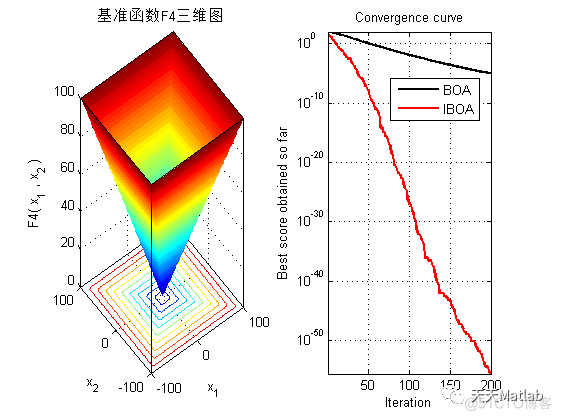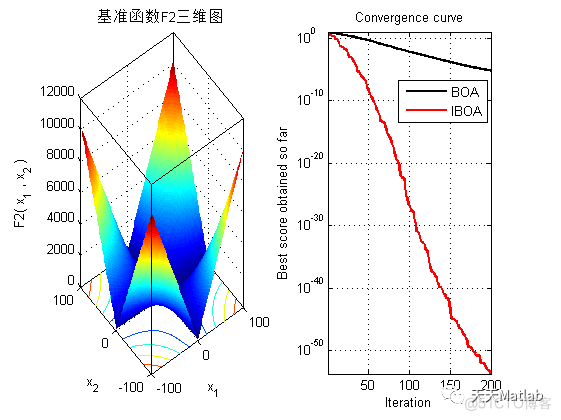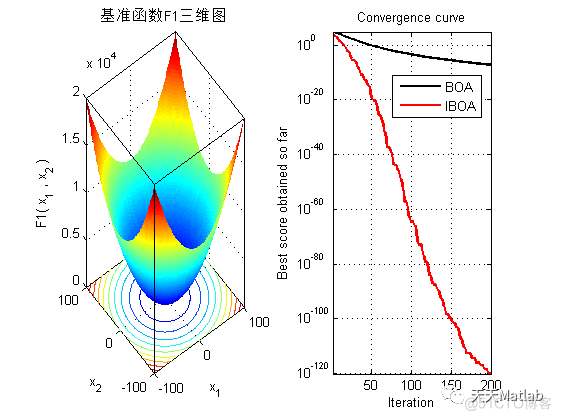✅作者简介:热爱科研的Matlab仿真开发者,修心和技术同步精进,matlab项目合作可私信。
🍎个人主页:Matlab科研工作室
🍊个人信条:格物致知。
⛄ 内容介绍
蝴蝶优化算法是近年来提出的一种新型自然启发式算法.针对基本蝴蝶优化算法收敛速度慢,求解精度低,稳定性差等问题,提出了一种融合变异策略的自适应蝴蝶优化算法.通过引入随机惯性权重策略,利用迭代次数和个体适应度的优邻域扰动策略调整转换概率,有效维持了算法全局探索与局部搜索的平衡;通过动态转换概率策略,利用惯性权重值和混沌记忆权重因子进一步提高了算法的多样性,有效避免算法早熟收敛,同时加快了算法的收敛速度和求解精度.利用改进算法对12个基准测试函数进行仿真实验,与基本蝴蝶优化算法对比表明,改进算法具有收敛速度快,寻优精度高,稳定性强等优异性能.
⛄ 部分代码
function [fmin,best_pos,Convergence_curve]=BOA(n,N_iter,Lb,Ub,dim,fobj)
p=0.8; % probabibility switch,开关概率
power_exponent=0.1; % 幂指数
sensory_modality=0.01; % 感觉因子
%Initialize the positions of search agents
Sol=initialization(n,dim,Ub,Lb);
for i=1:n
Fitness(i)=fobj(Sol(i,:));
end
% Find the current best_pos
[fmin,I]=min(Fitness);
best_pos=Sol(I,:);
S=Sol;
% Start the iterations -- Butterfly Optimization Algorithm
for t=1:N_iter
for i=1:n% Loop over all butterflies/solutions
%Calculate fragrance of each butterfly which is correlated with objective function,计算与目标函数相关的每只蝴蝶的香味
Fnew=fobj(S(i,:));
FP=(sensory_modality*(Fnew^power_exponent)); % 每只蝴蝶的香味
%Global or local search
if rand<p
dis = rand * rand * best_pos - Sol(i,:); % 全局搜索阶段
S(i,:)=Sol(i,:)+dis*FP;
else
% Find random butterflies in the neighbourhood
epsilon=rand;
JK=randperm(n);
dis=epsilon*epsilon*Sol(JK(1),:)-Sol(JK(2),:); % 局部搜索阶段
S(i,:)=Sol(i,:)+dis*FP;
end
% Check if the simple limits/bounds are OK
S(i,:)=simplebounds(S(i,:),Lb,Ub);
% Evaluate new solutions
Fnew=fobj(S(i,:)); %Fnew represents new fitness values
% If fitness improves (better solutions found), update then
if (Fnew<=Fitness(i))
Sol(i,:)=S(i,:);
Fitness(i)=Fnew;
end
% Update the current global best_pos
if Fnew<=fmin
best_pos=S(i,:);
fmin=Fnew;
end
end
Convergence_curve(t,1)=fmin;
%Update sensory_modality,更新感觉因子
sensory_modality=sensory_modality_NEW(sensory_modality, N_iter);
end
% Boundary constraints
function s=simplebounds(s,Lb,Ub)
% Apply the lower bound
ns_tmp=s;
I=ns_tmp<Lb;
ns_tmp(I)=Lb;
% Apply the upper bounds
J=ns_tmp>Ub;
ns_tmp(J)=Ub;
% Update this new move
s=ns_tmp;
function y=sensory_modality_NEW(x,Ngen)
y=x+(0.025/(x*Ngen));
⛄ 运行结果



⛄ 参考文献
[1] 李彦苍, 卜英乔, 朱海涛,等. 融合最优邻域扰动和反向学习策略的蝴蝶优化算法[J]. 中国科技论文, 2021, 16(11):8.
[2] 刘凯, 代永强. 融合变异策略的自适应蝴蝶优化算法[J]. 2022.
[3] 刘景森马义想李煜. 改进蝴蝶算法求解多维复杂函数优化问题[J]. 电子学报, 2021, 049(006):1068-1076.





















 974
974











 被折叠的 条评论
为什么被折叠?
被折叠的 条评论
为什么被折叠?








